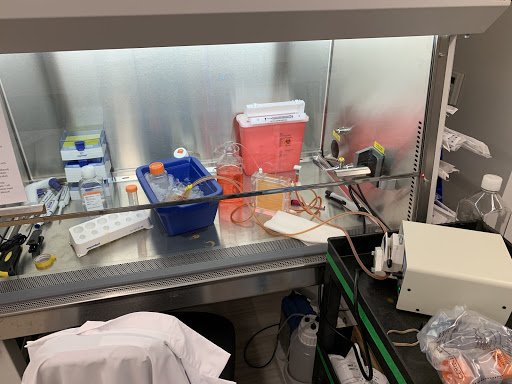Year in review 2020
Looking back, 2020 was quite the year. We designed 200 unique oncolytic viruses, and we confirmed 163 viruses are working (replication competent) in the lab. Among these, we engineered 42 glycoproteins, 29 promoters and 14 therapeutic genes. We generated more than 10 billion virus particles over the year, which we tested in 11 research cell lines and 8 patient derived cells. Building on our in vitro success, we also conducted 2 mouse studies.
How did the year unfold chronologically?
In January, we moved into Biolabs New York. Biolabs is an amazing biotech co-working space with all the necessary equipment to get us going. We even have our own private lab. Here is what it looked like back when we moved in.
We hit the ground running with the construction of 12 new viruses in January.
In February, we welcomed Taylor to the team. Chad knew him from our earlier research we conducted at Auburn University. With twice the amount of people in the lab, we hoped to double our speed.

In March, the pandemic hit. We decided to continue our work on oncolytic viruses and we also decided to make a vaccine. We were worried about the impact of COVID-19 on society and the potential lives it would take. We believed we would be able to help, using our technology.
In May, we confirmed we had a functional vaccine candidate that expressed the spike protein and bound ACE2 receptors. This result validated our design process.
In June, we started manufacturing large quantities of virus for the first time. For lab testing, we had typically produced around 1-10M virus particles. For in vivo studies and testing the safety of the vaccine, we needed to manufacture 1-10 billion virus particles. To accomplish this, we started using multi-layer cell factories. In addition, we needed to figure out downstream bioprocesses, such as purification and concentration. It took several trial runs, but after optimizing the process we can now produce 10 doses (of 1e9 particles/ml) in a matter of a week. Pretty cool.


In the summer we were also making good progress on our cancer research. We confirmed positive results with our glycoprotein engineering, making our viruses cancer-specific and much safer. Other labs and research groups have constructed viral therapies with single or dual promoters. To demonstrate the power of our platform, we successfully created a virus armed with 10 promoters. As far as we know, nobody has ever attempted this before.
In September, we completed our first animal study, which focused on evaluating the safety of our vaccine in rats. Based on the results, we are confident it is safe, but we were unable to confirm immunogenicity. Pity. (If you want to know more, read here about the conclusion of our vaccine study).
October was another big month for us. We tested our first cancer therapies in mice. This experiment presented several new challenges. Getting the right cell lines to our collaborator’s lab, since we do not have our own animal housing facility. Making sure they form tumors, so we can treat them. And manufacturing the right doses of our viruses that meet quality requirements. Ultimately, we did not get the results we wanted, because the tumors did not reduce in size. However, we did learn that our artificial viruses were safe though. The mice did not display any negative side effects or adverse reactions.
In December, we began our second mouse study. While the results came in January, we can share that they were very encouraging! We saw a substantial increase in survival for the treated mice.
Here’s a picture of our lab in December. As you can see there is a lot more going on than in January.
Looking back, we have advanced from our first virus designs in December 2019 to positive results in mice in just over a year. We cannot wait to see what 2021 will bring. We look forward to sharing it with you here on our blog.